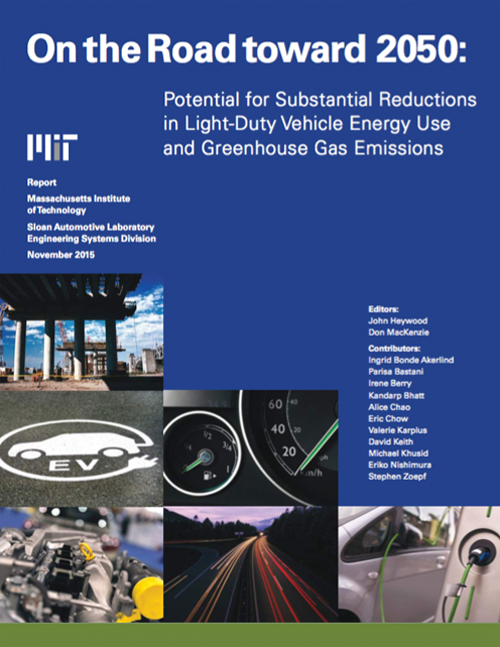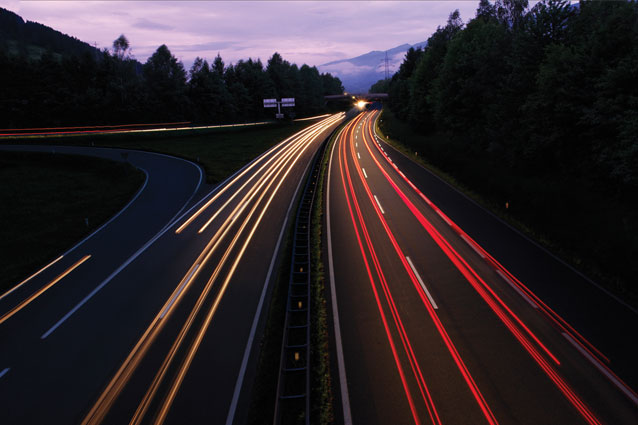
On the Road toward 2050
Potential for Substantial Reductions in Light-Duty Vehicle Energy Use and Greenhouse Gas Emissions
Abstract
Foreword by John Heywood, Sun Jae Professor of Mechanical Engineering Emeritus:
This report summarizes the results of an ongoing research program that assesses the extent to which improvements and changes in powertrain and vehicle technologies, and fuels changes, could reduce the fuel consumption and greenhouse gas (GHG) emissions of light-duty road vehicles. This research was done by a team of graduate students from 2009 to 2014, and includes some 20 projects. It continues our groups efforts to provide a more complete summary of the various options available, and an increasingly detailed knowledge base with which to assess these options, as we move forward. It follows on from three earlier reports: On the Road in 2020 published in 2000 and On the Road in 2035 published in 2008, and a strategy and policy-based report, An Action Plan for Cars, published at the end of 2009.
The report consists of a sequence of chapters, each devoted to an important component in our overall assessment of the options for reducing the energy use and GHG impacts of this major sector in our land-based passenger transportation system. The initial two chapters develop the context within which this sequence of key topic areas is examined. Subsequent chapters focus in turn on: the several propulsion system options in the various types of light-duty vehicles, and their operating characteristics; vehicle weight reduction potential and its impacts; the inherent vehicle performance, fuel consumption, and vehicle size trade-offs; fuel and alternative energy opportunities for this transportation sector and their infrastructure challenges; the process by which improved and new technologies diffuse into the in-use vehicle fleet; driver behavior and vehicle use impacts; extensive scenario analysis of various technology and energy pathways forward that quantifies changes in fuel use and GHG emissions in the United States, Europe, Japan, and China; the policy options available for further reducing these impacts; a summary and set of recommendations.
This final chapter (Chapter 11) provides an overall summary of the key findings in these various areas, and brings these findings together to assess how much the in-use light-duty vehicle fleet fuel consumption and GHG emissions might be reduced in major world regions. The results of plausible yet aggressive scenarios in the United States show the potential for technology improvements to more than offset fleet growth and, by 2050, reduce fuel use and GHG impacts by up to 50 percent. In Europe, the anticipated fleet growth is less, as are the potential reductions from technology improvements, but the overall percentage reduction potential is similar to that in the United States. In Japan, fleet size and use are declining, so the overall reduction in impacts could be larger. In China, though current growth in fleet size is large, reductions in that growth rate and substantial technology improvements over time are expected to level off fleet fuel consumption and GHG emissions by about 2040.
Chapter 11 ends with several recommendations focused on actions that we should consider implementing in the United States and elsewhere. Such actions are likely to be needed to attain close to the factor of two reductions in fleet fuel consumption and GHG emissions by 2050 that our overall assessment indicates are feasible in North America, Europe, and Japan. Larger reductions on this time scale will need additional major efforts, and would likely require significant reduction in travel demand, and more rapid development and substantial distribution and use of low-GHG- emitting alternative sources of transportation energy such as electricity and hydrogen. In China, where vehicle sales and fleet growth rates are expected to be high over the next decade or so, these reductions in fleet impacts will be delayed for two or so decades.
Overall, we believe that this report will help us better identify the more promising options for reducing this light-duty-vehicle component of transportations energy consumption and GHG emissions. We have developed and characterized what we judge to be realistic, though aggressive, paths forward. Achieving these improvements in mainstream powertrain and vehicle technology and starting to transition to one or more of the greener alternative energy sources in a significant way are very important, but very challenging, tasks. It is clear that coordinated and reinforcing policies are going to be required to achieve the needed changes in vehicle technology, energy sources, and vehicle use.
I want to thank the many graduate students and colleagues who have worked collaboratively with me at MIT over the past 16 years on these multidisciplinary technology-based projects. Together as a team which individuals join, work on their own research as well as contribute more broadly, then finish and move on we have stimulated each other in very constructive and creative ways. I have found carrying out such multi-faceted research in this manner extremely rewarding at the professional and personal level. Finally, I would also like to thank Rebecca Marshall-Howarth for her editorial assistance and Karla Stryker-Currier for her administrative assistance. They were both instrumental in producing this book. Thank you all very much.
